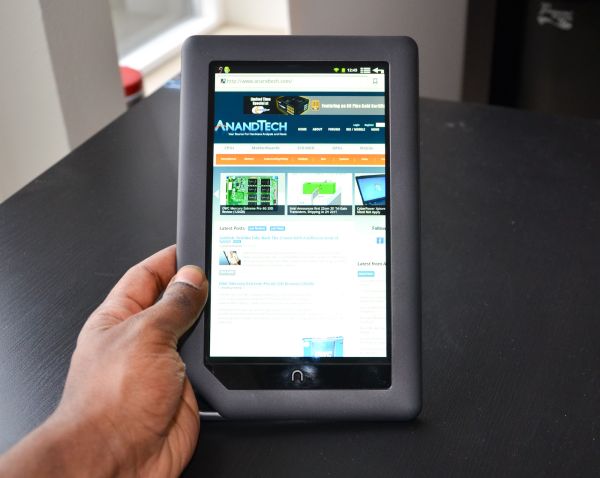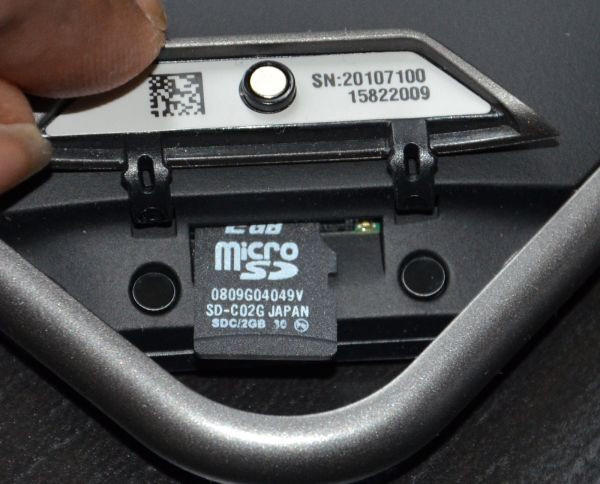Battle of the Budget Tablets - Nook Color vs. Galaxy Tab
by Vivek Gowri on May 25, 2011 12:52 AM ESTMeet the Contenders - Nook Color
The Nook Color is an interesting case. It’s technically an e-reader, and the included Android ROM never lets you forget that. But the spec-sheet says differently. A 7” 1024x600 IPS display, an OMAP3 SoC, and Android 2.2 for $249? Sounds like a budget tablet to me.
Gallery: Barnes & Noble Nook Color
On a hardware level, that’s basically what it is. As with most tablets, the front face is screen dominated, with a slightly larger-than-normal raised bezel and a stylised N beneath the display acting as the home button. The design of the Nook Color was handled by Yves Béhar and his team at fuseproject, one of the leading industrial design firms in the country.
You’d expect a device coming out of an elite design studio to have a very polished design, and the Nook Color definitely does. The design elements are very cohesive, with a final product that is at once attractive and very functional. The bezel is rendered in a metallic-look matte dark gray plastic, with a near-black rubberized back cover. Connecting the front and back faces is a matte silver rim around the four sides of the device, acting as a plastic band holding the device together. It’s a nice look, with slightly cooler shades of gray (probably 3-5% saturation of blue), and more importantly, the rounded edges make it very comfortable to hold, almost like a thin hardcover book. Almost makes you wonder if they meant for you to read books on it...

But the most notable industrial design feature of the Nook Color has to be the nook (for lack of better word) in the bottom left corner. It’s like a larger version of the through-holes you can find on some MP3 players and cell phones, but with basically no function beyond housing the microSD card slot (unless you really are planning on attaching a 7” tablet to a lanyard.) It’s more of a design quirk, one that adds a bit of character to the device, but an aesthetic element through and through. I’m a fan; it does a lot to break up the monotony that most tablets, especially ones with large bezels, suffer from while also making an amusing play on the Nook’s name.
The buttons and ports are built into the silver colored band, with the power button on the left side near the top, and the volume buttons near the top on the right side. The headphone jack is on the top and the microUSB on the bottom, as God intended them. The microSD card slot is built into the edge of the “nook” on the backside, under a flap bearing the Nook logo.
Overall, the Nook Color is bigger and heavier than the Galaxy, but that gives it a more significant feel in hand, and it definitely feels more durable and rugged than most of the other tablets out there. This is a combination of the larger bezel, the rubberized back, and the high quality matte plastic, and a welcome one. It’s a $250 device that really doesn’t look or feel like it.
Unfortunately, the spec sheet sheds some light on why it’s so much cheaper than the Galaxy. Let’s start with the CPU - it’s an OMAP3 processor, which means Cortex A8 and PowerVR SGX 530. So far so good. Specifically, it’s the OMAP 3621, an 800MHz part that is the basis of TI’s eReader platform. Okay, so an 800MHz A8 isn’t going to set the world ablaze, but it’s definitely livable, especially if we’re planning on tossing a bare-bones ROM onto this thing. Here’s the weird part. Like the Droid 2, the 3621 uses an IVA 2 DSP decode chip, and it can only do SD resolution video decode. So no 720p video.
Which is kind of a pity, because the display is gorgeous. It’s a 7” IPS WSVGA panel with a great contrast ratio, but we’ll get to that in a bit. Rounding out the rest of the specs, we see 512MB RAM, 8GB of onboard flash storage plus the microSD expansion slot, 802.11g wireless, an 8 hour battery, and a distinct lack of any cameras.

















89 Comments
View All Comments
MossySF - Monday, May 30, 2011 - link
The specs for Archos 70 say:• High resolution screen, WVGA 800 x 480 pixels, 7'' TFT LCD, 16 million colors
• Capacitive multitouch screen
Yes on the resolution. No on resistive.
medi01 - Wednesday, May 25, 2011 - link
" Overclocked kernels, custom skins and launchers, updating the ROM to the latest nightly build, anything you could possibly dream of. That's something you just won't get with the Samsung..."Samsung Galaxy Tab was rootable even back in 2010.
ironmb - Wednesday, May 25, 2011 - link
I will never understand this new fad of tablets.. to each is own i guess.mi1stormilst - Wednesday, May 25, 2011 - link
Bought one for my wife, rooted in about 15 minutes she uses it for reading and gaming and surfing. Not everything works perfectly, but the battery life is more than decent and it is very much a usable product. We read from both the Kindle App and the B&N App with no trouble. I got it during the Ebay B&N sale for $199 enough said :-)IdBuRnS - Wednesday, May 25, 2011 - link
My wife uses my rooted CN all the time for playing Angry Birds. loldukepeter - Wednesday, May 25, 2011 - link
It seems like the WiFi-only Galaxy Tab packs OMAP3* as well, not Hummingbird.this was reported here: http://www.thegalaxytabforum.com/index.php?/topic/...
can anybody confirm?
DanNeely - Wednesday, May 25, 2011 - link
Did you read the article before posting this? It does so.Stanil - Wednesday, May 25, 2011 - link
In the original it said Hummingburd and PowerVR 540, they changed it post factum :) Thx for the specs, I wasn't sure if the castrated version was only for Europe.dukepeter - Wednesday, May 25, 2011 - link
yes, i read the article, and i remember clearly it said Hummingbird and PowerVR SGX540.But yes, they have changed it now. i wish i had been wrong =|
VivekGowri - Wednesday, May 25, 2011 - link
Yeah sorry, I had changed it on my document file but apparently not the actual article engine before posting - sorry guys, that was a big time proof-reading error by me.It felt very bait-and-switch to me, I never noticed it was SGX 530/OMAP3 until I ran the gaming tests and went o_O. I don't mind too much about downgrading the Bluetooth, but the SoC downgrade is pretty terrible.